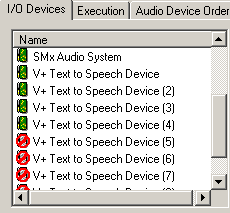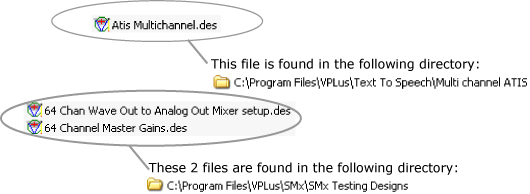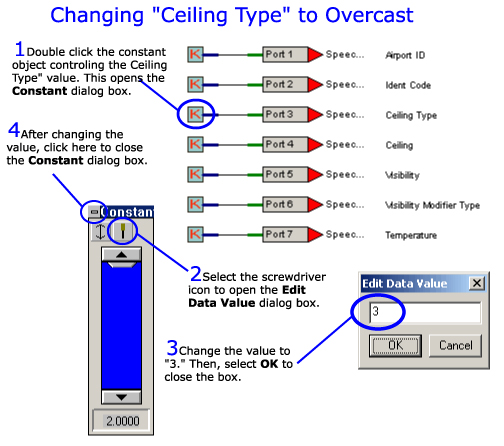
 This tutorial demonstrates how to use the Text-to-Speech
I/O Device for V+ to run 4 different ATIS
channels simultaneously on one audio output, using V+,
Text-to-Speech I/O Device and an SMx Audio System.
This tutorial demonstrates how to use the Text-to-Speech
I/O Device for V+ to run 4 different ATIS
channels simultaneously on one audio output, using V+,
Text-to-Speech I/O Device and an SMx Audio System.
These instructions are for SMx systems only.

This demo requires the items listed below. If SimPhonics' software is not installed on your system, you can download by clicking on the product name.
-
WindowsXP/2000
-
SMx Audio System
-
Monitor
-
Speaker with 1/4" connector

-
Connect monitor to computer chassis.
-
Apply power to the SMx breakout boxes.
-
Apply Power to the computer chassis.
-
Connect the speaker to Line Output #1.

Enabling and Configuring the I/O Devices
The SMx Audio System and Text-to-Speech (TTS) I/O devices need enabling before they are used. In addition to enabling, the TTS device also needs configuring. Configuration includes assigning physical output channels and text template files to each TTS channel. This tutorial assigns all TTS channels to play out the same physical output. However, if you have multiple speakers, the TTS channels can be assigned to play to any physical outputs. Although there are a total of 8 TTS channels, only the first 4 are configured, since they are the only channels used in this demo.
-
Select All Programs > V+ > V+ Run-time System from the Start menu to launch the V+ Run-Time system.
-
Select File > Open from the V+ Run Time System menu bar
-
Open the ATIS.VNE configuration file found in the following folder:
C:\Program Files\VPLus\Text To Speech\Multi channel ATIS\
-
If the error message listed below appears, select OK.

-
Select Configure to open the Platform Configure dialog box.
-
From the I/O Devices tab, double click SMx Audio System to remove the red circle from the icon and enable the device

-
Double click the first 4 V+ Text to Speech devices to enable these devices.

-
Select the first V+ Text to Speech Device and select the Configure button. This opens the Speech Synthesizer Configuration dialog box.
-
Select the TTS Template File Name
 button.
button. -
Locate and open the following text template file:
C:\Program Files\VPLus\Text To Speech\Multi channel ATIS\Atis1.txt
-
Select OK to close the Speech Synthesizer Configuration dialog box.
-
Select the next TTS device, V+ Text to Speech Device (2), and select the Configure button. This opens the Speech Synthesizer Configuration dialog box.
-
Select the TTS Template File Name
 button.
button. -
Locate and open the following text template file:
C:\Program Files\VPLus\Text To Speech\Multi channel ATIS\Atis2.txt
-
Select OK to close the Speech Synthesizer Configuration dialog box.
-
Select the third TTS device, V+ Text to Speech Device (3), and select the Configure button. This opens the Speech Synthesizer Configuration dialog box.
-
Select the TTS Template File Name
 button.
button. -
Locate and open the following text template file:
C:\Program Files\VPLus\Text To Speech\Multi channel ATIS\Atis3.txt
-
Select OK to close the Speech Synthesizer Configuration dialog box.
-
Select the fourth TTS device, V+ Text to Speech Device (4), and select the Configure button. This opens the Speech Synthesizer Configuration dialog box.
-
Select the TTS Template File Name
 button.
button. -
Locate and open the following text template file:
C:\Program Files\VPLus\Text To Speech\Multi channel ATIS\Atis4.txt
-
Select OK to close the Speech Synthesizer Configuration dialog box.
-
Select OK to close the Platform Configure dialog box.
Running the V+ Design
 After the I/O devices are configured, three V+ worksheets are
opened. In addition to an ATIS worksheet, the SMx demo requires 2 additional V+
worksheets. These extra V+ designs contain SMx ports and
settings needed to
use V+ with an SMx audio system..
After the I/O devices are configured, three V+ worksheets are
opened. In addition to an ATIS worksheet, the SMx demo requires 2 additional V+
worksheets. These extra V+ designs contain SMx ports and
settings needed to
use V+ with an SMx audio system..
-
Select the
 shortcut to launch the V+ Visual Programming System.
shortcut to launch the V+ Visual Programming System. -
Select File > Open from the V+ Visual Programming System window and locate and open the VPLus design files listed below. The first file contains the multiple ATIS channel setup. The last 2 designs contain SMx ports and are necessary when using V+ with an SMx system. These designs are not needed when using a desktop system.

-
Select the
 shortcut, located at the top of the V+ Visual Programming System window, to start the designs.
shortcut, located at the top of the V+ Visual Programming System window, to start the designs.

-
Select Yes. The designs should now be successfully running. This is indicated in the message box, located in the bottom left corner of the V+ Visual Programming System window.


-
 Once the platform is running,
return to the V+ Run-time System
to hear the output. The run-time system window must
have focus before any speech is heard.
Once the platform is running,
return to the V+ Run-time System
to hear the output. The run-time system window must
have focus before any speech is heard.
Dynamically Controlling the Speech
There are a couple ways to change the output when the designs are running.
To change the text file
-
Open any of the ATIS text files assigned during configuration.
-
Change the text in the file, being careful to follow scripting guidelines. You can find help with scripting and control tags in the V+ Text-to-Speech I/O Device User Manual.
-
Save and close the file. The changes are heard after the current loop is played.
To change the V+ Port Values
Go to the V+ Visual Programming System window and open the ATIS Multichannel.des file, if it is not already open. The diagram below shows how to change a port value. When finished, return to the V+ Run-Time System. The changes are heard after the current loop has finished playing.

-
When finished with the application, return to the V+ Run-Time System and select the
 shortcut. This stops the V+ design.
shortcut. This stops the V+ design. -
Select Save to save the autostart.vne file configuration. This step, saves the 2 SMx worksheets to the configuration file.
Note: The procedure above is only necessary the first time you run the application. Once the ATIS.VNE file is successfully ran and saved, you can start the program by opening and running the ATIS.VNE file. However, the worksheets must be open in order to change Constant object values controlling the speech.
There are many variables you can dynamically change when using this device. The demo only touches a few of these. Download the V+ Text-to-Speech I/O Device User Manual for more information.
Contact SimPhonics if you have any questions/comments.
